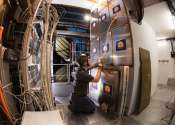The European Organization for Nuclear Research (French: Organisation européenne pour la recherche nucléaire), known as CERN ( /ˈsɜrn/; French pronunciation: [sɛʁn]; see History), is an international organization whose purpose is to operate the world's largest particle physics laboratory, which is situated in the northwest suburbs of Geneva on the Franco–Swiss border (46°14′3″N 6°3′19″E? / ?46.23417°N 6.05528°E? / 46.23417; 6.05528). Established in 1954, the organization has twenty European member states.
The term CERN is also used to refer to the laboratory itself, which employs just under 2400 full-time employees, as well as some 7931 scientists and engineers representing 608 universities and research facilities and 113 nationalities.
CERN's main function is to provide the particle accelerators and other infrastructure needed for high-energy physics research. Numerous experiments have been constructed at CERN by international collaborations to make use of them. It is also the birthplace of the World Wide Web.
- Address
- 1211 Genève 23, Geneva, Canton of Geneva, Switzerland
- Website
- http://www.cern.ch/
- Wikipedia
- http://en.wikipedia.org/wiki/CERN
Some content from Wikipedia,
licensed under CC BY-SA
Subscribe to rss feed







